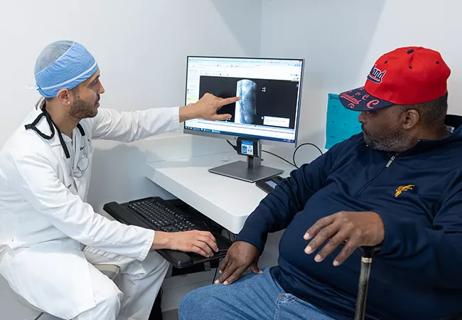Newer insulin regimens require accurate dosing

Cleveland Clinic is a non-profit academic medical center. Advertising on our site helps support our mission. We do not endorse non-Cleveland Clinic products or services. Policy
Aliyah* was only 8 years old. She was always a happy, healthy little girl who loved to play with her brothers and sisters — and then run back inside to snack on whatever her mom had cooked up for her family.
Her family had recently moved to the United States from Saudi Arabia. She enjoyed eating pizza and was not quite sure about pasta yet. Her mother cooked most of the meals in her family and followed age-old recipes passed on by word of mouth, using fragrant spices and fresh ingredients not always found in fancy cookbooks.
Aliyah’s world was turned upside down this year when she started going to the bathroom a lot, losing weight and was finally diagnosed with Type 1 diabetes. When Aliyah’s family met the diabetes team at Cleveland Clinic Children’s, her mother’s main concern was “How do I cook traditional foods for her anymore?”
Technological advances and pharmaceutical discoveries have revolutionized the treatment of Type 1 diabetes. New insulin analogs, advanced delivery systems such as the insulin pump and continuous glucose monitors have made glucose sensing and the insulin titration much easier for children and their families. Accurate dosing of insulin based on blood sugar and carbs consumed are critical to optimal management of Type 1 diabetes.
Mealtime insulin dosing still relies on accurate carbohydrate counting — on the patient being able to estimate the amount of carbohydrate (in grams) expected to be eaten in a meal. In the past, carbohydrate counting was taught as “exchanges,” each exchange equaling 15 grams of carbohydrate. This is a relatively easy way of counting carbohydrates, but compromises on accuracy. Newer insulin regimens require accurate dosing with little room for ‘guesstimation’ or rounding.
In Aliyah’s case, medical student Hamza Nasir, MD, and I were faced with a dilemma when her mom posed her question about carbohydrate counting for ethnic foods. We found plenty of Arabic language translations of diabetes education materials. We also located a few research articles that provided examples of cuisine-specific nutritional information that we provided to the family. Finding easy- to-read, cuisine-specific carbohydrate counting materials online was difficult.
Although it would seem that carbohydrate counting resources would be more easily accessible, it is important to note that most readily available food lists are catered toward cuisines eaten in Europe or North America. Translations tend to be nonspecific and do not address carbohydrate counting or portion sizes of traditionally prepared foods. Resources published in different countries are sometimes only in the native language and not validated for accuracy. There are extensive ethnic food resources available, but they tend to focus on the nutritive value of each ingredient, rather than on a typical meal. These resources tend to be in the form of research articles, lacking patient-friendly advice.
As most traditional foods are prepared from a multitude of raw, indigenous ingredients with many variations of recipes passed on through generations, portioning and carbohydrate counting become an arduous task for families of young children who are still coming to terms with a new diagnosis of Type 1 diabetes in their toddler or child.
In a time when the world has become a global village, clinicians increasingly encounter cultural diversity in their practices. It is imperative that diabetes associations look into providing easily accessible tools online in different languages that address carbohydrate counting of ethnic foods.
It would be ideal to have a centralized database that consolidates all of the information available regarding ethnic foods and their carbohydrate counts. This would allow clinicians to help relieve the burden of carbohydrate counting on families, allowing children with Type 1 diabetes to achieve optimal glycemic control while enjoying traditional home-cooked meals.
* Patient name has been changed to protect privacy

Radiofrequency ablation significantly reduces symptom severity, shrinks nodules

Maternal-fetal medicine specialists, endocrinologists and educators team up

Giving young patients a hand as they take charge of their own health

Case illustrates how easily condition can mimic preeclampsia

Analysis examines surgical resection of rare pituitary tumors

Screening and medication key to better outcomes

Spinal cord stimulation can help those who are optimized for success

Incidence, outcomes and management